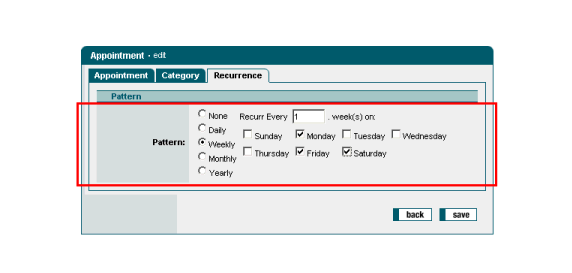| Attribute | Type | Description | Req. | RTExp |
| accesskey | String |
The accesskey attribute can be used to specify a shortcut
key for the <LABEL> (activated by pressing Alt and
the accesskey togther).
| |
|
| align | AlignmentType |
Specifies the horizontal alignment of the element.
-
left
=
left alignment
-
right
=
right alignment
-
center
=
center alignment
| |
|
| colspan | Integer |
Specifies the column span of a form element
within a multi column form
| |
|
| description | String |
The description text.
| |
|
| disabled | boolean |
This attribute can be used to disable the control element.
It then does not accept any user inputs and does not
generate any control element events.
| |
|
| height | String |
Sets the height of the form element. The height
may be specified in absolute or percent terms.
Annotation:
See HTML documentation for the attribute height.
| |
|
| help | String |
Allows to assign a help id for the element. If set, a help symbol
will be displayed beside the element, which will generate an onHelp
event if the icon is clicked. The id can be used to display a special page
of the help system. The help system is not part of the Common-Controls
Framework.
To generate the hyperlink some default framework resources where used:
| Resource Key | Description | Default |
| fw.help.onclick | An optional onclick script handler. The handler can include
a {0} placeholder for the help id | - |
| fw.help.target | Specifies the target where to open the hyperlink | _blank |
| fw.help.tooltip | A tooltip for the hyperlink | context help |
Annotation:
A jump screen of the Help system must be specified.
| |
|
| id | String |
Assigns the control element a unique identifier.
Using the given Id, the Java variable can be accessed
in the tag Body.
The id must be a string literal because the JSP
compiler generates a variable with this name at compile
time
Annotation:
A valid Java identifier must be given.
| |
|
| imageref | String |
Pointer to an element of the Imagemap of the form.
The image is drawn before the label of the element.
| |
|
| join | Boolean |
Indicates that two adjacent form elements should be
joined together
| |
|
| label | String |
The label of the form element.
| |
|
| labeltooltip | String |
Tooltip on for the label of the form element.
| |
|
| name | String |
Specifies the name of the Java-Bean. The Java-Bean must be stored
in the given scope.
When the tag is surrounded by a Struts <html:form> tag, no Bean Name need be
specified. In this case, the Java-Bean is drawn via a property of the Struts Form Bean.
Annotation:
A valid Java identifier must be given.
| |
|
| permission | ACL |
With this attribute, access to the element can be restricted.
Authorizations are checked using the com.cc.framework.security.Principal
object in the user session. The principal object is registered in the session
with the method com.cc.framework.security.SecurityUtil#registerPrincipal(HttpSession, Principal).
It is made available by the application developer by implementing the principal
interface. In this manner, any authorization system can be very easily connected
within the framework.
Authorizations are always specified in the form of an Access Control List (ACL).
What is involved here is a semicolon-delimited list with individual authorizations.
The framweork supports the following authorization types, which, however, can be
expanded at will by the application developer:
- Literal
- true|false -> com.cc.framework.security.StaticPermission
- Role
- #rolename -> com.cc.framework.security.RoleBasedPermission
- Function
- $functionname -> com.cc.framework.security.FunctionBasedPermission
| |
|
| property | String |
Specifies the name of the property using which the Java-Bean
is to be accessed. This is generally only necessary when the
Java-Bean is associated with a Struts Form Bean.
Annotation:
A valid Java identifier must be given.
| |
|
| required | boolean |
Indicates whether the form element involved is a mandatory input.
Mandatory fields are displayed highlighted for the user's convenience.
| |
|
| scope | HTTPScope |
This attribute shows the Scope in which the
Java-Bean with the actual display data can be found.
-
any
=
The Bean is searched for in ever Scope.
-
page
=
The Bean exists as a local variable in the JSP Page.
-
request
=
The Bean is in the HTTP-request.
-
session
=
The Bean is in the HTTP-Session.
-
application
=
The Bean is in the Servletkontext.
| |
|
| style | String |
An HTML-style can be directly specified with this attribute.
Annotation:
See HTML documentation for the attribute style.
| |
|
| styleClass | String |
The HTML-class attribute of the element can be specified with this attribute.
Annotation:
See HTML documentation for the Attribute class.
| |
|
| styleId | String |
The HTML-id attribute of the element can be specified with this attribute.
Annotation:
See HTML documentation for the Attribute id.
| |
|
| tabindex | Integer |
Tabulator Index for this element.
| |
|
| tooltip | String |
A short descriptive text that is displayed when the user
moves the mouse over the element.
| |
|
| valign | AlignmentType |
Specifies the vertical alignment of the element.
-
top
=
top alignment
-
bottom
=
bottom alignment
-
center
=
center alignment
| |
|
| width | String |
Sets the width of the form element. The width
may be specified in absolute or percent terms.
Annotation:
See HTML documentation for the attribute width.
| |
|
